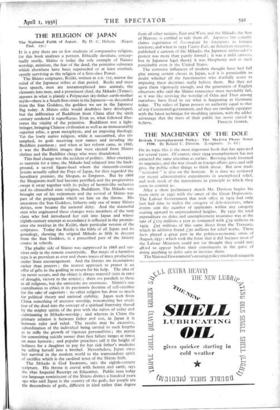THE RELIGION OF JAPAN
The National Faith of Japan. By D. C. Holtom. (Kegan Paul. r5s.) IT is a pity there are so few students of comparative religion, for this book analyses a portent. Ethically destitute, concep- tually sterile, Shinto is today the sole example of Nature worship, animism, the fear of the dead, the primitive substrata which elsewhere have been superseded or at least overlaid, openly surviving as the religion of a first-class Power.
The Shinto scriptures, Kojiki, written in A.D. 712, mirror the mind of the Japanese tribes at that period. Rocks and trees have speech, men are metamorphosed into animals, the elements into men, and a prominent chief, the Mikado (Tenno), appears in what is plainly a Polynesian sky-father earth-mother myth—there is a South Seas strain in the Japanese—as descended from the Sun Goddess, the goddess we see in the Japanese flag today. A Shinto ethic would doubtless have developed, but the infiltration of Buddhism from China after the sixth century rendered it superfluous. Even so, what followed illus- trates the vitality of the primitive. Buddhism was a light- bringer, bringing Chinese civilisation as well as an immeasurably superior ethic, a great metaphysic, and an imposing theology. Yet the lowly native religion, while it succumbed, also tri- umphed, its gods receiving new names and invading the Buddhist pantheon ; and when at last reform came, in 1868, it was the Buddhist images that were ejected from Shinto shrines and the Buddhist clergy who were disendowed.
This final change was the accident of politics. After emerging as suzerain for a time, the Mikado had relapsed into the back- ground, a sacred figure-head whom the sixteenth-century Jesuits actually called the Pope of Japan, for they regarded the hereditary premier, the Shogun, as Emperor. But by 1868 the Shogunate itself had become petrified, and the progressives . swept it away together with its policy of hermit-like seclusion and its chinesified state religion, Buddhism. The Mikado was brought out of his retirement and the revival of Shinto was part of the propaganda which set him on the throne. His ancestress the Sun Goddess, hitherto only one of many Shinto deities, now became the national deity. And the masterful men who engineered these changes were members of the very clans who had introduced her cult into Japan and whose eighth-century attempt at ascendancy is reflected in the promin- ence she receives in the Kojiki, their particular version of the scriptures. Today the Kojiki is the bible of all Japan and its genealogy, showing the original Mikado as fifth in descent from the Sun Goddess, is a prescribed part of the history course in schools.
The phallic side of Shinto was suppressed in 1868 and sur- vives only in the remote countryside. But magic of a harmless type is as prevalent as ever and shows traces of mass production -under State encouragement. And the litanies are incantations rather than prayers ; the nearest approach to prayer is an offer of gifts to the godling in return for his help. The idea of sin never occurs, and the object is always material (rain in time of drought, victory to the armies) ; there are parallels to these in all religions, but the omissions are enormous. Shinto's one contribution to ethics is its passionate doctrine of self-sacrifice for the sake of superiors : no other religion has done so much for political theory and national stability. Japan took from China something of ancestor worship, transmuting her crude fear of the dead into the concept of a spiritual fraternity shared by the mighty spirits of the past with the rulers of today and culminating in Mikado-worship ; and whereas in China the primary relation is between father and son, in Japan it is between ruler and ruled. The results may be excessive, subordination of the individual being carried to such lengths as to stifle the growth of vigorous personalities ; the mania for committing suicide sooner than face failure verges at times on mass hysteria ; and popular preachers call it the height of holiness for a daughter to pay for her sick father's medicine by selling herself into a brothel. Nevertheless, Japan owes her survival in the modern world to the transcendent spirit of sacrifice which is the cardinal tenet of the Shinto faith.
The Mikado is God Incarnate, says the eighth-century scripture. His throne is coeval with heaven and earth, says the 1890 Imperial Rescript on Education. Public men today use language reminiscent of the Shinto divines a hundred years ago who said Japan is the country of the gods, her people are the descendants of gods, different in kind rather than degree
from all other nations, East and West, and the Mikado, the Son of Heaven, is entitled to rule them all. Japanese law actually Claims cognisance of Ise-majeste by foreigners in foreign territory, and when in r935 Vanity Fair, an American magazine, published a cartoon of the Mikado, the Japanese ambassador's protest was more than purely formal ; it was a mild cartoon, but in Japanese legal theory it was blasphemy and as such punishable even in the United States.
The corrosive influences of modern thought have had full play among certain classes in Japan, a.,:d it is permissible to doubt whether all the functionaries who dutifully assist in imposing these doctrines really believe them. But they act upon them vigorously enough, and the generation of English observers who said the Shinto renascence must inevitably fail, as it was like reviving the worship of Odin and Thor among ourselves, have lived to see what is happening in Germany today. The rulers of Japan possess an authority equal to that of any Continental government, and they are similarly equipped with the latest technique for moulding opinion, with the added advantage that the mass of their public has never ceased to














































 Previous page
Previous page